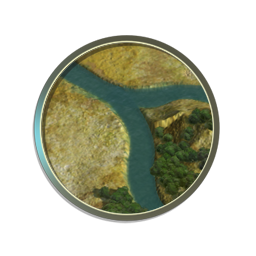Amphibious Invasions
From the halls of Montezuma, to the shores of Tripoli.
From the halls of Montezuma, to the shores of Tripoli.
Introduction
Whether it is Troy, Normandy, or the Pacific Campaign that is the first thing that comes to your mind, Amphibious Invasions have occurred throughout history. Now Amphibious Invasions apply to more than just an island hopping campaign, or a massive beach landing. These kinds of assaults apply to crossing rivers or small channels of water.
No matter what type of map you are on, sooner or later, either out of necessity or as a strategic option, you are going to have to land on hostile shores. This guide is setup to help you not only prepare for an Amphibious Invasion, but also to prepare to defend against one.
Before we dive right in, I am going to assume you know the basics of the combat mechanics in Civ5. If you do not, I would highly recommend that you get familiar with the mechanics first before you dive into this guide. Play the tutorials that came with the game, or check out any of the other outstanding guides found in the War Academy. The main three I would recommend are, The Mechanics of Combat, Understanding the Zone of Control, and Ranged Combat.

- Key Concepts
- Preparation for D-Day
- D-Day
- The Coastal Fortress
- Alternative Options
- Specific Civilization Strategies
- Conclusion
Key Concepts
- 1UPT = One unit per tile.
- Direct Assault = Attacking directly from the sea.
- Indirect Assault = Disembarking first, then attacking.
- Ocean = Sea (and vice versa)
- Coast = Any portion of your territory on the sea, NOT the terrain type.
- Preparation is key!
- Location, location, location!
Preparation for D-Day
You are going to need a couple of things before we start hitting the shores. For starters, some basic technology is in order. Namely, you are going to need Optics which will allow for the embarkation of your units. Unlike previous Civilization games, you do not need transports. On the plus side, this means you can build more combat units instead of having to build a large number of transports.

Civilization 5 allows only one unit per tile (1UPT), which means that preparing for an invasion is going to get rather crowded. If you are already at war, or have a large barbarian population close by, then your units should stay on the shores. Your units cannot defend themselves while embarked, which will make them easy pickings. There are two exceptions that are addressed in the Specific Civilization Strategies section.
You may find it useful to grab the Amphibious Promotion if you have the option, as it will negate the penalties for attacking from the sea and over rivers. However, if you are only attacking one or two cities from the sea or across rivers, then the Amphibious Promotion won't be as useful as a terrain bonus or cover.
At the same time as building your invasion force, you are going to need to build a couple of naval combat vessels as well. Depending on your opponents navy, you might want 2-3 or as many as 4-6. Your fleet should have a mix of targeting promotion based ships and bombardment promotion based ships. The exact ratio of anti-naval ships vs bombardment support will depend on your targets current fleet. Do not mix and match on the same unit however. Pick a track and stick with that one track!
The reason for the mixed fleet is that, for any amphibious invasions, you will need to first remove the targets fleet and then shift to bombardment support. Since embarked units are easily removed by a ship 'running it over', ensuring the target has no fleet before bringing your embarked units over is a good tactic. Early on your options are limited, but that is for another topic, which is discussed *here* (add link for Naval Combat Guide when completed)

Once you are ready, make sure your entire force is embarked before you set off. You lose the rest of your movement points once you embark, so failing to embark can cost you precious time!
Summary
- Research Optics (to allow embarkation).
- Build your invading army.
- Use beneficial promotions if available.
- Build an appropriate navy for escort and shore bombardment.
- Embark the entire invasion force.
Now that your units are embarked, off we go! At this point you might be asking yourself, "to where?" The obvious answer is towards your enemy! If you are at war, then you will want to take your warships to screen ahead and to the flanks of your embarked units. Since most civilizations embarked units (Songhai units and Spanish Conquistadors prevent this) can be killed by a ship 'running it over' (entering the same tile) you never want to allow an enemy ship to get close to your embarked units. As well, there is no naval Zone of Control, so enemy naval units can go right past yours. Finally, you'll need the space to allow your embarked units to be within striking distance of the coast.
Once you are on the way to the target, you will need to choose a suitable landing position. You should be preferring an area where you can land at least 1/2 your army in the first wave. Melee units need to land closer to the enemy units or city, while ranged units can land in a second wave, or behind melee units if the terrain allows.

Try to land your forces in tight clusters. Flanking bonuses will help your units survive the first turn, as they won't be able to continue attacking on the turn they land. (Danish units can move after landing) Additionally, a Great General is worth bringing, and they do not need to land on the shore to give out bonuses. So if you have more than one battle zone when you land, you can shift your Great General around on the sea tiles to help your units.
If the target has units in the landing zone, use your navy to soften them up before trying to land. (or just land beside them and clear them on the next turn) Without the amphibious assault promotion, attacking from the sea is generally considered a bad plan unless you will kill the unit outright.
While you are bombarding the shore with your naval units, set up your invasion forces in a formation that mimics what that which you will use on land. Melee and hard hitters first, then the ranged units, including any siege units. The reason for this is that with only 1UPT you are going to have to hit the shores in waves and you do not want to be shuffling units mid-landing.
One particular pitfall to beware of is amphibious assaults against Japanese units. They will still deal maximum damage to your units even if wounded, and you will have a -50% combat strength penalty, without the amphibious assault promotion, meaning that you will take a great amount of damage just getting on to the shore, even against a one hit point unit.
If you are planning on landing close to an enemy city, ensure your navy is taking up every coastal tile touching the city. If you do not, the enemy will be able to continue building ships, which can then move out and kill your embarked units.
Summary
- Scout ahead and to the flanks.
- Choose a suitable landing zone.
- Shore preparation.
- Formation preparation.
- Hit the Beaches!
Sooner or later, you are going to need to deal with the situation of hostile units landing on your shores. This section is setup to specifically address this situation.
Your first layer of defenses and biggest asset in the defending your shores from invaders is going to be naval reconnaissance. If you see it coming, you are going to have a lot more time to adequately prepare and ultimately interdict the enemy force. So, if you suspect an Amphibious Invasion the first thing you are going to need to do is have a respectable navy.

A rule of thumb is that you should be able to have 3-4 ships able to reach any part of your shore within two turns. So the larger the shoreline, the more ships you will need to defend it. You should have a minimum of two ships near every coastal city at all times, when you are at war. These ships help maintain the trade routes and can quickly dispatch any ship that wants to pillage your sea resources. All defensively focused ships should have the targeting promotion line, as this will help you kill off invading ships much faster.
With a respectable navy afloat, you will want to do recon on any and all approaches from the sea. That means hugging the coast, or straight across the oceans. This is why you want enough ships to be able to watch your whole coast so that every turn you will be able to see all of your land beyond the vision afforded by your borders.
Once you have spotted an invasion fleet, ensure to engage them out at sea with your ships, unless their fleet is larger than yours. If you focus your fire and kill at least one ship per turn, you can very quickly decimate your opponent's invasion forces after the naval battle. If that is not possible, or their fleet is larger than yours, you may need to fall back to the shoreline to let your city and ranged units help dispatch enemy ships.

As well, if you have an Air force available, use them to pick off the enemies embarked units. Air units instantly kill embarked units. Do watch out for enemy carriers though. If you spot one, kill it as fast as you can since they will be carrying fighter, bombers, or worse - an Atomic Bomb!
Basically, as long as the enemy has an invasion force, your navy should fight to the last man. Once the invasion moves to the land, use your navy to kill stragglers and prevent reinforcements.
Unfortunately, they might make it to your shores. Even if they prepared the landing zone, you should still be at a strong advantage. Should the enemy make it to your second layer of defenses, it is time to use your ranged units to pound them on their approach. You might only get one or two barrages off before they land, so be sure to not get stuck on the shore. If they are going straight for a city, focus on the biggest threats first, and focus your fire!
Once it looks all clear, check for other approaches, a second wave and prepare an invasion of your own. Assuming they are not crying for peace!
Summary
- Recon.
- Interdiction.
- Artillery Barrage.
- Bloody Shores.
- Cleanup
This section deals primarily with the non-standard Amphibious Invasions from simply crossing a river hex to using a large lake as a surprise invasion route.
River Crossings

The most basic of Amphibious attacks is the crossing of a river. Historically speaking, rivers have always made excellent natural barriers to deter an invasion from all but the most determined attackers.
For the most part, using ranged units to clear all enemy units near the river before crossing is a very good plan. However, eventually you will need to cross the river. You will lose your turn after crossing the river, (except for scouts and American Minutemen based units) so do pay attention to where you are crossing. Try not to leave yourself flanked by enemy units, or in a marsh if you're close to the enemy.
The Amphibious Promotion will negate the penalty for attacking across a river with melee units, so having one or two units with this promotion can make river crossings less brutal.
Large Lakes, Small Seas, Etc
This scenario allows for larger amounts of embarked units, with less focus on navies. A few ships would never be a bad thing, if you share an inland sea with an enemy. Otherwise, going across the Large Lake/Inland Sea with your units can be a much more effective method of assault, than if you tried to fight your way around it. This can be a very easy way to dodge the enemies army and hit their less protected areas.
Crossing the Channel
Sometimes, you have an island or landmass separated by a thin channel of water. One strategy that is practiced upon the discovery of Radar, is to use Paratroopers to drop on the opposite side of the channel to secure positions or delay defenders while troops cross the channel.
While Paratroopers cannot attack on the same turn as their drop, they can move around and pillage tiles. This allows you to use them to 'fortify' a coastal area while the rest of your army is moving through the water. Once there, the paratroopers can move out of the way to allow your other units to land unopposed.
Using City States and Open Borders effectively
If there happens to be a City State near your landing zone, which isn't at war with you, then you can choose to land your embarked units in their territory. This can be a very nice way to get your units on to dry land before actually starting a war. (if you were not at war with the target already) Yes you will lose influence with that city state, but they complain less than an AI about your units being in their territory.
You can also choose to buy Open Borders from an AI next to your target. This, again, will allow you to safely land your units before commencing an attack. You will however have to deal with the AIs units wandering around, which can get in your way. As well, they may ask about your forces, so be sure not to accidentally declare war on them.
This strategy is also good if mixed with paying off the landing zone civ to attack the target civ. They will more than likely send their units to their death, allowing you more space to land and move your units. If you're extra lucky, the target civ will move it's units into the landing zone civ's territory, allowing you to pick them off before getting close to their cities.
Operation Overkill
One way to ensure minimal loss during an Amphibious Invasion is to clear the way with a couple of nukes. With the technology Computers and Advanced Ballistics, you could simply perform a first strike from a Nuclear Submarine with a Nuclear Missile (or two) and annihilate anything on the landing zone. This could also be done earlier on the tech tree with Flight and Nuclear Fission with a Carrier and an Atomic Bomb (or three).
Specific Civilization Perks
Listed below in alphabetical order are several Civilizations that have a slight edge during an Amphibious Invasion. Note that in some cases, it is very technology dependent.

- Their Berserker (replaces Longswordsman) starts with the Amphibious Promotion.
- All Danish units can move after landing. Their movement points at landing are based upon their embarked movement points. Danish units also have +1 embarked unit speed.
- +2 Movement for Naval Units (including embarked units)
- Ship of the Line (replaces Frigate) can see farther, is cheaper, and slightly stronger ranged attack.
- Foreign Legion (Replaces Infantry) has a combat bonus outside of friendly territory.

- Bushido means that even if at 1HP, they are still a threat.
- Embarked Units can defend themselves.
- Embarked Conquistadors can defend themselves.
An Amphibious Invasion is a lot like a land invasion, with a couple of exceptions. It takes time, additional recon, and a little extra support to take ground. However, when defending against an Amphibious Invasion, a little preparation and aggressive tactics goes a long way.
Patch version of this article: 1.0.1.383
